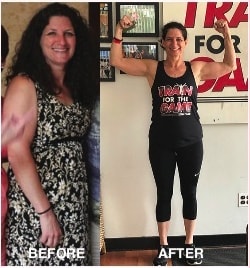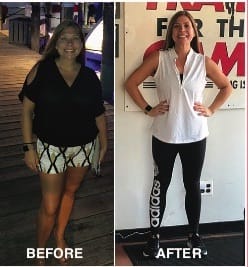Exercise blunts your hunger during and after training.
The adage to eat when you’re hungry isn’t wholly accurate when it comes to people who exercise a lot. That’s because longer bouts of intense exercise can mess with your hunger cues both during your training and afterward.
When you’re exercising, your body naturally redirects your blood away from your digestive tract to send oxygen to your working muscles. This creates an environment that affects your gut microbiome and appetite hormones, Stacy Sims, PHD, an athlete performance physiologist based in New Zealand whose research focuses on women, tells SELF. Specifically, this lack of blood flow in the GI tract suppresses ghrelin, the hormone that elicits hunger, effectively killing your appetite during your workout and for some time after.
The harder and longer you exercise, the more likely you are to notice appetite suppression, says Samuel—which can explain why you feel ready to chow down on breakfast after a 30-minute jog, but aren’t interested after a 60-minute run. There’s no clear consensus on exactly how long exercise can blunt your appetite, but in general, it can take up to a couple hours to feel hungry again after a workout, Samuel says. In fact, one small study that looked at elite male soccer players found that those who had exercised at moderate and high intensity for two hours showed lower levels of acylated ghrelin (the form of the hormone that stokes appetite) for two hours after their activity than people who had simply rested for four hours.
Ghrelin isn’t the only hormone at play, either, says Dr. Sims. Researchers recently discovered a molecule known as Lac-Phe that’s also responsible for appetite suppression during and after exercise. “The more intense the exercise, the greater the concentration [of Lac-Phe]; and the greater the concentration, the more the appetite is suppressed,” says Dr. Sims.
What’s more, the environment you’re exercising in can also affect your hunger cues. If you don’t feel like eating during or after exercising in hot, humid conditions, it’s not just you. A small 2021 study published in Nutrition and Metabolism had 18 adults spend time exercising and staying sedentary in three different environments: cold, moderate, and hot. The researchers found that the participants felt greater suppression of their appetites when they exercised in the heat compared to when they did so in the cold.
Why does proper fueling matter anyway?
Okay, so exercise messes with your hunger cues. But how bad is it, really, to use your own perceptions of hunger to determine how you fuel your body?
It can actually lead to some pretty serious effects. If you’re basing your fueling on your hunger cues, and your hunger cues are all out of whack, you may not be giving your body the nutrients it needs to perform all that hard work optimally or recover from it, either. Dr. Sims uses the classic car analogy: “Would you drive on fumes and expect to make it?” she says.
Just like a car needs fuel to get to where it needs to go, you need adequate nutrition to reach your goals, too, says Dr. Sims. Take performance, for one. Going into exercise under-fueled—especially without adequate carbohydrates, which drive hard exercise—impairs both your training intensity and the duration of your workout, according to the American College of Sports Medicine’s (ACSM) position statement. Nutrition continues to play a role after your session too: Taking in enough protein after exercise can help accelerate recovery, especially during the period where delayed-onset muscle soreness, or DOMs, kicks in.
Then, of course, there’s the cumulative health effects that go beyond exercise. Over time, chronic underfueling can set the stage for low energy availability (LEA), a syndrome caused by eating insufficient calories to support your activity, says Dr. Sims. This can affect your menstrual cycle—a lack or irregularity of periods in an athlete who menstruates can be a huge red flag that something’s amiss— hormones, metabolism, bone density, immunity, cardiovascular system, and mental health. And the slide into LEA, Dr. Sims says, “starts with fasted training and delayed post-exercise nutrition.”
Taking in adequate nutrition for activity helps maintain levels of the sex hormones that regulate menstruation, which helps support your bone density, sex drive, energy levels, and mental health, says Samuel. What’s more, she says, proper fueling also plays a key role in preventing injuries and burnout, which is important for allowing athletes to train consistently.
So how can you make sure you’re properly fueled even if you’re not hungry?
Your optimum fueling strategy is highly individualized, Starla Garcia, RD, a Houston-based dietitian and marathoner, tells SELF. While your body can always benefit from refueling after any workout, there are, however, three questions that can help you determine whether you need food ASAP.
1. Are you hungry? This one’s the simplest: If the answer is yes, you should definitely eat, says Garcia.
2. Is your workout duration long? If your workout lasts 60 minutes or more, no matter its intensity, make it a point to eat before, after, and possibly during your workout, Garcia says. This holds true whether you’re hungry or not. (Beginners may want to consider 45 minutes their benchmark, she says.)
3. Is your workout intensity high? If your workout contains any higher-intensity intervals, even if the total duration is less than 45 minutes, you should also consider eating before, after, and possibly during as well, says Garcia.
If you answered “yes” to any of these questions, here’s how you can put proper fueling into practice for those long, hard efforts:
What to do before a workout
If you’re working out long or hard in the morning, it’s important to have something for breakfast, says Garcia—even if you don’t wake up hungry.
Morning pre-workout fuel becomes even more vital if you slept poorly the night before, says Garcia. Cortisol, your body’s primary stress hormone, is naturally elevated right when you wake up—and it can be even higher if you’re sleep-deprived. As part of the “fight or flight” response, cortisol triggers the release of glucose into your bloodstream (so you’ll be ready to “fight”), which means you’re going into your workout with elevated blood sugar. Once you start exercising, “your blood sugar is going to drop immediately,” which can result in issues like decreased energy, brain fog, and irritability, says Garcia. All of this is a perfectly natural physiological response to exercise and your circadian rhythm, but the effects become amplified if you’re adding in intense exercise on top of them.
But eating before your workout, particularly something carb-y with a little protein in it, helps keep your blood sugar stable for longer, which can translate to more even, sustained energy and better performance, Garcia explains. Even a small pre-workout breakfast can be a game-changer, she says.
What to eat depends on how much time you have before your workout, says Samuel.
The closer you are to your workout, the more you should prioritize simple carbs, such as graham crackers, pretzels, or cereal, which digest more easily and quickly. If you absolutely can’t stomach the thought of solid food early in the morning, there’s nothing wrong with calorie sources that go down easy, like juice and applesauce, says Samuel.
Here’s how much Garcia recommends taking in:
- For a short session (30–40 minutes or so): Shoot for about 15 to 30 grams of carbohydrates—roughly the amount in a normal-size banana.
- For a longer session (an hour or more): Shoot for 45 to 100 grams of carbs for a longer session, more as the duration and intensity increase. For reference, a packet of instant oatmeal, half a banana, and eight ounces of orange juice nets you 54 carbs.
If you have at least two hours before your workout, you may be able to digest a larger, more balanced meal without risking GI upset. In that case, go ahead and incorporate some fat and protein, Samuel says. “This could look like a peanut butter and jelly sandwich, turkey sandwich, oats with nuts and fruit, or toast with eggs.”
What to do during your workout
For workouts lasting more than an hour, or ones that are very intense, taking in some nutrition during your workout can be helpful, both for performance and for setting your body up for success later.
While there are no one-size-fits-all recommendations for what to eat during a long or hard session, there are some general guidelines you can use as a starting point:
- For a one- to two-hour workout: Take in at least 30 to 60 grams of carbs per hour, says Samuel. What to eat depends on what your stomach can tolerate, but generally, you’ll perform best with a mix of sports drinks and solids, including gels and chews that offer a mix of glucose, fructose, and starch, says Samuel. For instance, two packets of GU energy gels will give you about 46 grams of carbs, while a 20-ounce bottle of Gatorade contains 36 grams.
- For a workout over two hours: Shoot for 60 to 120 grams of carbs per hour, Samuel says.
What to do after your workout
If you’re famished after your workout, great—go ahead and eat! But if your hunger cues are all out of whack, it’s important to make yourself take in some fuel anyway.
This may mean not listening to your body at this moment: It’s important to note that you may feel just fine going about your day without refueling because of your blunted hunger cues. But your brain might have already started sounding the alarm bells. According to Dr. Sims, when you’re not getting enough calories to support your activity, your body perceives the presence of a major stressor (think famine) and reacts accordingly, starting the hormonal response that can eventually lead to LEA.
If you’re feeling the effects of blunted hunger, try to make yourself eat “as soon as you can'' afterward, says Garcia. You don’t necessarily have to scarf down a meal before you shower, but you should try to get in some food within an hour of your workout, she says.
The earlier you eat, the sooner you start the recovery process. “This is needed to stop the breakdown state—the catabolic state—of exercise and start the anabolic/repair/muscle building process,” says Dr. Sims. According to the ACSM, try for about 1 to 1.2 grams of carbs per kilogram of bodyweight during the first hour after your workout, and continue taking in carbs over the next few hours with either more snacks or a meal.
Here’s what that can look like:
- Shoot for a ratio of 3:2 to 3:1 carbs to protein. That means for every 60 grams of carbs, you’d aim for 20 to 30 grams of protein, too, says Garcia. A bagel with a glass of chocolate milk, for instance, will get you there. Other snack options you can mix and match from include yogurt with honey and pumpkin seeds, toast, cottage cheese, a handful of nuts, or a muffin.
- If you can’t stomach solids right away, focus on liquids: Mixing up a smoothie—think fruit-rich for carbs and added protein powder—can go down relatively easily, says Samuel. Or you can pair a protein shake with juice or a sports drink.
You should also make sure you’re rehydrating afterward. The ACSM recommends taking in 125–150% of the fluid you lost during your activity. For instance, if you weigh yourself before and after activity and see you lost 16 ounces, you’d want to replenish with 22 to 24 ounces. As SELF reported previously, people generally lose between 17 to 68 ounces in sweat per hour during intense exercise, so if you don’t have a scale, you can use that amount as a rough benchmark.
Be gentle with yourself during this process.
The transition to fueling yourself appropriately, especially when you’re not relying on your hunger cues, is a process. For one, it may require a mental health shift, to get yourself into the right headspace to eat when your body isn’t telling you to.
Don’t blame yourself if you’re having trouble! It takes a huge amount of effort to tune out the prevailing message (i.e. diet culture), telling us thinner is always better, and that the only appropriate time to eat is when you’re actually hungry. If you’re struggling and have the means, consider reaching out to a registered sports dietitian. Especially if you’ve struggled with disordered eating in the past, you may want to seek out a pro who takes a non-diet or intuitive eating approach. (You can find one in the directory of certified intuitive eating professionals.)
Keep an open mind—and a lot of patience as you try things out. “It takes a lot of repetition and being open to experimentation” to perfect your nutrition game Garcia says. Keep track of what works for you and how you’re feeling and performing over time. It’s absolutely a process, says Garcia—it takes time to figure out the best plan for you, one that helps you feel strong, energized, and ready to keep crushing whatever workout’s ahead.



